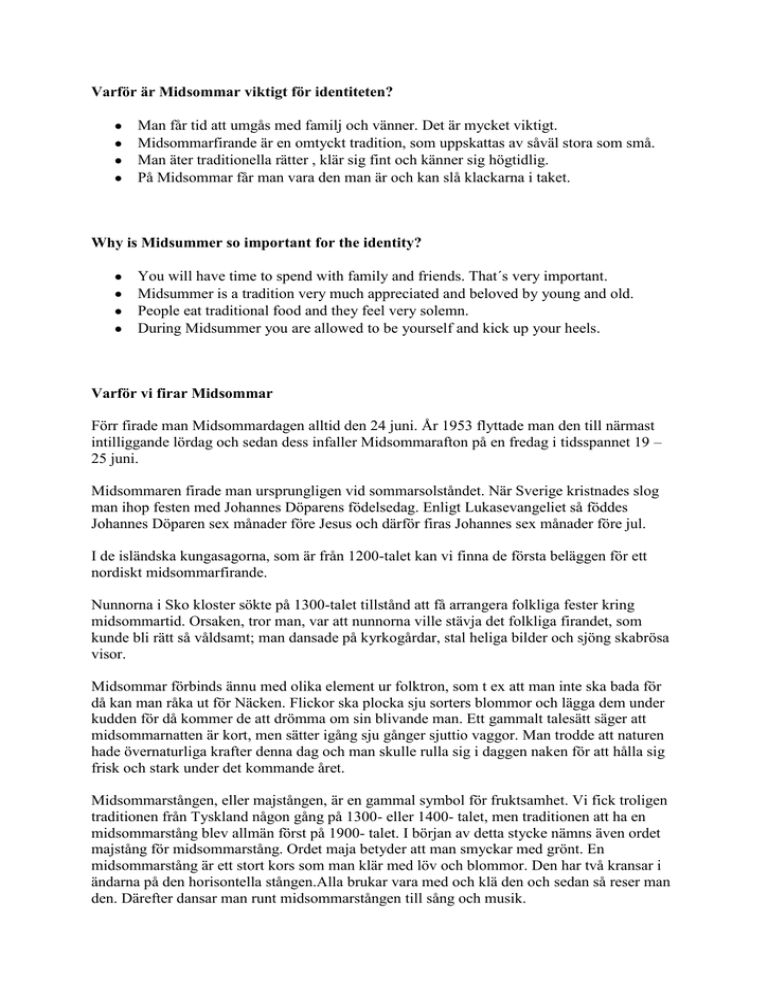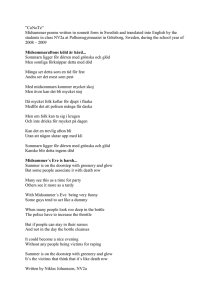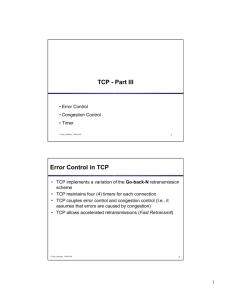
Varför är Midsommar viktigt för identiteten?
Man får tid att umgås med familj och vänner. Det är mycket viktigt.
Midsommarfirande är en omtyckt tradition, som uppskattas av såväl stora som små.
Man äter traditionella rätter , klär sig fint och känner sig högtidlig.
På Midsommar får man vara den man är och kan slå klackarna i taket.
Why is Midsummer so important for the identity?
You will have time to spend with family and friends. That´s very important.
Midsummer is a tradition very much appreciated and beloved by young and old.
People eat traditional food and they feel very solemn.
During Midsummer you are allowed to be yourself and kick up your heels.
Varför vi firar Midsommar
Förr firade man Midsommardagen alltid den 24 juni. År 1953 flyttade man den till närmast
intilliggande lördag och sedan dess infaller Midsommarafton på en fredag i tidsspannet 19 –
25 juni.
Midsommaren firade man ursprungligen vid sommarsolståndet. När Sverige kristnades slog
man ihop festen med Johannes Döparens födelsedag. Enligt Lukasevangeliet så föddes
Johannes Döparen sex månader före Jesus och därför firas Johannes sex månader före jul.
I de isländska kungasagorna, som är från 1200-talet kan vi finna de första beläggen för ett
nordiskt midsommarfirande.
Nunnorna i Sko kloster sökte på 1300-talet tillstånd att få arrangera folkliga fester kring
midsommartid. Orsaken, tror man, var att nunnorna ville stävja det folkliga firandet, som
kunde bli rätt så våldsamt; man dansade på kyrkogårdar, stal heliga bilder och sjöng skabrösa
visor.
Midsommar förbinds ännu med olika element ur folktron, som t ex att man inte ska bada för
då kan man råka ut för Näcken. Flickor ska plocka sju sorters blommor och lägga dem under
kudden för då kommer de att drömma om sin blivande man. Ett gammalt talesätt säger att
midsommarnatten är kort, men sätter igång sju gånger sjuttio vaggor. Man trodde att naturen
hade övernaturliga krafter denna dag och man skulle rulla sig i daggen naken för att hålla sig
frisk och stark under det kommande året.
Midsommarstången, eller majstången, är en gammal symbol för fruktsamhet. Vi fick troligen
traditionen från Tyskland någon gång på 1300- eller 1400- talet, men traditionen att ha en
midsommarstång blev allmän först på 1900- talet. I början av detta stycke nämns även ordet
majstång för midsommarstång. Ordet maja betyder att man smyckar med grönt. En
midsommarstång är ett stort kors som man klär med löv och blommor. Den har två kransar i
ändarna på den horisontella stången.Alla brukar vara med och klä den och sedan så reser man
den. Därefter dansar man runt midsommarstången till sång och musik.
Danser och sånger etc
Små grodorna: Man sjunger, hoppar runt och låtsas vara grodor
Enebärabusken: Man sjunger sången och gör rörelser till
Ägg/potatis på en sked: Man balanserar ett ägg/en potatis på en sked som man håller
med munnen och går runt midsommarstången
Räven raskar över isen: Man sjunger om olika yrken och gör gester till
Morsgrisar är vi allihopa: Sång och dans kring midsommarstången
Snapsvisor: Sånger man sjunger när man skålar vid matbordet
Blomsterkrans till håret: En flätad krans med blommor som man sätter i håret
Prästens lilla kråka: Man sjunger denna sång och gungar ut och in från
midsommarstången
Midnattsdopp: Man tar ett dopp mitt i natten såvida man inte är rädd för näcken
Mat
Färsk potatis
Olika sorters inlagd sill
Snaps och öl
Gräddfil med gräslök
Jordgubbar med glass eller jordgubbar med socker, grädde eller mjölk
Why we celebrate Midsummer
Before Midsummer´s Day was always celebrated June 24. Since 1953 Midsummer´s day is
celebrated on a Saturday that is nearest to June 24 and since then Midsummer`s Eve is always
on a Friday between June 19 – 26.
Midsummer was originally celebrated at Summer solstice. When Sweden was Christianized
Midsummer was celebrated on the same day as the birthday of John the Baptist. According to
the Gospel of St Luke John the Baptist was born six months before Jesus and that is why
John the Baptist is is celebrated six months before Christmas.
In the Icelandic stories about the kings from the 13th century we can find the earliest
evidences of Nordic Midsummer celebration.
The nuns of the nunnery of Sko asked in the 14th century for permission to arrange popular
festivals around Midsummer. The reason is said to be that they wanted to put a stop to the
wild celebrations at this time of the year. People used to dance in the cemeteries, to steal holy
pictures and to sing indecent songs.
Midsummer is still connected to old folklore as not to bathe because then because you could
meet the Neck. Girls are supposed to pick seven different flowers and put them under their
pillows and they will then dream about their future husband. An old phrase says that
Midsummer´s night is short but it starts seven times seventy cradles. People believed in
supernatural powers this day and if you rolled yourself naked in the dew you could keep
yourself healthy and strong during the coming year.
The Midsummer pole or the maypole is an an old symbol of fertility. The tradition with a
Midsummer pole comes from Germany to Sweden sometimes in the 14th or 15th century. But
this tradition to have a Midsummer pole became common as late as in the 20th century. In the
beginning of this passage you will find the word ”maypole”(majstång) for ”Midsummer
pole”. The word ”maja” means that you decorate with green leaves. A Midsummer pole is a
big cross that you decorate with branches of green leaves and flowers. The Midsummer pole
has two garlands hanging at each end of the horisontal pole. Everybody use to take part in the
decoration of the pole and after that the Midsummer pole is raised. And now people start
singing and dancing around the pole to music.
Dances and songs etc
The little frogs: You sing the frog song while dancing around acting like frogs
The little frogs, the little frogs are funny to observe
The little frogs, the little frogs are funny to observe
No ears, no ears, no tails do they possess
No ears, no ears, no tails do they possess
Kou ack ack ack, kou ack ack ack
Kou ack ack ack ack kaa
Kou ack ack ack, kou ack ack ack
Kou ack ack ack ack kaa
The Juniper berry bush: you sing the song and you do the movements related to the
song
Egg/potato on a spoon: you balance an egg or a potato on a spoon which is kept in
your mouth while you walk around the Midsummer pole
The fox runs across the ice: you sing about different professions making gestures
Everybody is a Mommy´s boy: you sing and dance around the pole
Drinking songs: Songs you sing when you make a toast at the dinner table
Garland of Summer flowers: a braided garland of flowers that you wear on your head
The priest´s little crow: when singing this song you walk towards and away from the
Midsummer pole
Midnight swim: You go for a swim in the middle of the night if you are not afraid of
the evil spirits of the waters or the Neck
Food
New potatoes
Different kinds of pickled herring
Schnaps and beer
Sour cream with chives
Strawberries with ice cream (vanilla ice cream)
Strawberries with sugar and cream/whip cream/milk






